John Hurrell – 29 March, 2023
Tuck's chronological reading lists, unfortunately in the publication, in impact overshadow her paint-handling skills and her many innovative choices in compositional options. Some of the writers are art historians whom I think cling too closely to various bibliographic details of Tuck's research-based reading life gained through conversation or text, instead of acknowledging that the artwork may have its own separate existence and internal logic, free of the wishes of the artist and her conscious intentions.
Christchurch
Barbara Tuck
Delirium Crossing
Curated by Christina Barton, Anna Miles and 14 invited art historians, writers and curators
Catalogue contributors include Susan Ballard, Christina Barton, Jan Bryant, Natasha Conland, Abby Cunnane, Richard Frater, Simon Gennard, Robyn Maree Pickens, Nathan Pohio, Rebecca Rice, Hanahiva Rice, Emma Smith, Lachlan Taylor, Sarah Treadwell, and Emma Fenton (researcher)
Touring exhibition initiated by Ramp in partnership with Anna Miles Gallery and Te Pātaka Toi Adam Art Gallery .
15 October 2022 - 26 March 2023
Barbara Tuck is a much experienced but surprisingly, comparatively little known, conceptualist painter (not a ‘landscapist,’ despite her ready use of them, but a global environmentalist preoccupied with time) long admired by curators as varied as Christina Barton, Allan Smith, Natasha Conland, Luit Bieringa, Priscilla Pitts, Jan Bryant and (once upon a time, wearing that hat) myself. You could call her a ‘painter’s painter’ but that—depending on where you say it—suggests the work is overloaded with scholarly research (its meanings uber-determined), dry without pleasure in its making or viewing.
If you called this senior artist ‘an academic’s academic’ there is a pinch of truth in that, for when reading the fourteen short essays by the guest writers in the accompanying catalogue her images are often linked to her copious parallel readings of poetry, botany, geology, micro-science, and history—so that for most works columns of pertinent footnotes have been readily assembled in a final section that the writers had no access to, even though they could interview the artist personally. It is clear Tuck loves manipulating thin oil paint. But she loves precisely planning the use of that manipulation too; the ends for which she devises the means.
The 14 works picked by the writers are surprisingly varied in their compositional and ideational approaches, yet the exhibition group also excludes the earlier paintings on cut aluminium. When approached by Anna Miles and Christina Barton, Tuck disliked the idea of a retrospective survey. Her resistance paid off. The selection of more recent paintings by the chosen writers turned out impressively rich, despite the presence of incongruously varied, differently coloured frames, alongside many not framed at all.
Most of the works are single squares of varied size. One (chosen by Bryant) is compositionally lopsided and looks as if it can be happily rotated to one of any four optional alignments. Barton selected Iris Gate, a set of six vertical rectangles, covered with pictographs that hint of an interest in the coding of written language. A narrative sequence is suggested in its order.
The other great thing about Barton’s choice is that Iris Gate (from 1999, the earliest work) references the cutout aluminium paintings, their vaguely petally/leafy animal forms, one shape even repeated three times in a single panel. It reminds us of where Tuck has been creatively.
Tuck seems to be a cross between Waikato painter Margot Philips and Australian painter William Robinson, but much more complex visually and conceptually. Her practice, the book emphasises, is based on specific visited sites and particular geological or climate periods she has researched. Some of the commissioned readings almost transmute the paintings to book lists or pages of citations, instead of material constructions, painted planes that are formally, spatially and ideationally, inventive.
For the catalogue the artist has provided meticulous records of her (nonmanual) intellectual pursuits while painting; it can be argued that they overshadow her paint-handling skills and her many innovative choices in compositional options. Some of the writers are art historians whom I think cling too closely to various bibliographic details of Tuck’s reading life gained through conversation or text, instead of acknowledging that the artwork may have its own separate existence and internal logic, free of the wishes of the artist and her conscious intentions.
With the accompanying anthology of texts, interview and lists of books read, Tuck is a catalyst where in a sense, her crafted images (but not her, the researching artist) are inevitably left behind through the process of ekphrasis, and the written citational sources of the titles are contextually abandoned—so that the quoted fragments of poems become revitalised through separation, and exposed when as evocative titles they are embedded in images.
The writer interpretations often remind me of Twombly exegesis, where Greek and Roman poems are pored over in relation to the scribbled words and parts of painted or drawn imagery that hover on the picture-plane. In comparison Tuck enjoys both receding space and the picture plane, mixing the macro with the micro, and avoiding a dramatic figure/ground distinction. The two co-exist, slide around, back and forth and up and down.
With Tuck the published anthology is very contemporary in its foci. Poetry along with ecology, climate, geology, human migration, ornithology and mythology dominates. It is an unusual, often quite brilliant, catalogue that is packed with surprises about this artist and her reading interests, and their relevance.
On most of the square panels, maps, charts, photos, pieces of patterned fabric, drawings, stacked vista, floating fragments of soil are mixed with alps, plains, foothills, rivers, glaciers, oceans and reflected night skies. Many of the botanical textures and earth colours are not of Aotearoa (more Australia, if any place), and in some of the icy glacial forms we see microscopic creatures that seem to be fast moving as if rendered cartoons. Surprisingly they have curving parallel motion lines. (I’m not sure if Tuck is being funny, or commenting on particle theory. Either way it is refreshingly unexpected.)
Despite a textual disclaimer where direct linear relationships between individual paintings and read references are denied, most of Tuck’s works have, as I’ve said, a list of academic annotations of books /articles/poems read during their construction. These were originally recorded in her diary.
I’m not sure this is a good idea: I personally think she should be a lot more secretive, to create wiggle room that entices writers to be more inventive and speculative in the way they view what is directly in front of them—rather than providing chronological lists writers can pick through so they can dig up new aspects hitherto undiscussed by earlier art historians. There seems to be too much emphasis on reading interests (an overcompensation perhaps, for all painters’ alleged stupidity mentioned by Duchamp) and not enough on the physicality of the panels and use of thin sticky stuff placed upon them—her use of inversion for example, or densely patterned botanical cramming, or the stacking up of vistas—and how they viscerally impact on the viewing experience.
This show and its catalogue is clearly a successful, widely admired project, but hopefully another, broader touring exhibition that includes the earlier cut aluminium works, will be planned soon.
John Hurrell
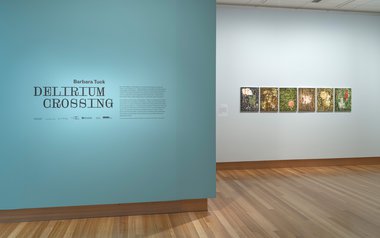
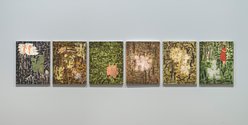
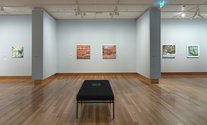
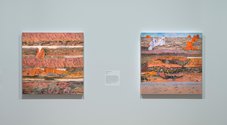
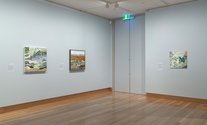
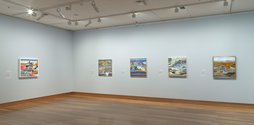
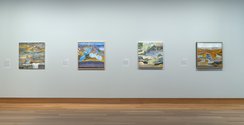
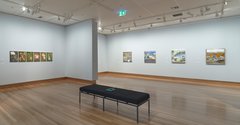
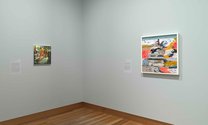
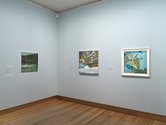
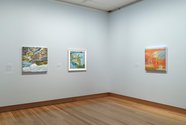

 Advertising in this column
Advertising in this column Two Rooms presents a program of residencies and projects
Two Rooms presents a program of residencies and projects


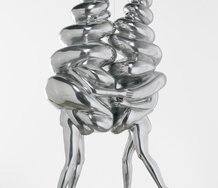
This Discussion has 0 comments.
Comment
Participate
Register to Participate.
Sign in
Sign in to an existing account.